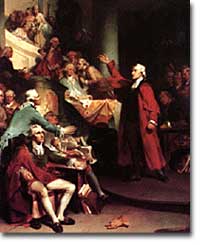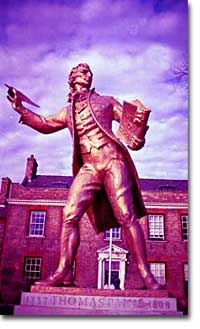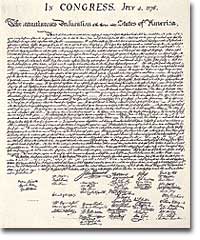


"Give me liberty, or give me death!" Patrick Henry's oratory against British taxation of American colonies was key in inspiring the Founding Fathers to declare independence.
"No taxation without representation!"
"These are the times that try men's souls."
"Give me liberty or give me death!"
All are famous phrases that sparked the American Revolution . In the view of many colonists, British rule suppressed political, economic, and religious freedoms. Many of those that hesitated to support independence were soon convinced by the passionate words of Thomas Paine , Samuel Adams , Patrick Henry , and eventually John Adams and Thomas Jefferson. The Declaration of Independence in 1776, the American Revolution, and the creation of the Articles of Confederation represent the American colonies' first attempt to become a nation. This incubation was tentative at best, but ultimately led to success.

Thomas Paine advocated the independence of the American colonies from Britain. The writings of Paine, Samuel Adams, and others convinced Americans to set up their own state and democratic government.
As tensions between Britain and the American colonies increased, a series of meetings were called, including that of the Second Continental Congress (1775-1776.) On July 4, 1776, the delegates approved the Declaration of Independence, the event that marks the birth of the United States. Thomas Jefferson, a delegate from Virginia, drafted the document primarily as a list of grievances against the king. His most important words, however, clearly shaped the philosophical basis of the new government. The famous introduction clearly reflected John Locke's social contract theory : ". to secure these rights [Life, Liberty, and the pursuit of happiness], Governments are instituted among men, deriving their just powers from the consent of the governed." Jefferson further reasoned that since the British government had abused these rights, the colonists had the right "to alter or to abolish it, and to institute new Government."


Shay's Rebellion showed the weaknesses of the Articles of Confederation. When the central government couldn't put down the rebellion, the first stirrings of federalism began to gather strength.
The British, of course, did not recognize the Declaration and continued to send troops to contain the rebellion. The war continued until 1783, so the new government had to be put in place in a wartime atmosphere. The Articles of Confederation, a compact among the thirteen original states, was written in 1776 but not ratified by the states until 1781. The loose "league of friendship" that it created reflected the founders' reaction to the central authority of King George III.
The government gave most powers to the states, and the central government consisted only of a legislature. Above all, the colonists wanted to preserve their liberties, but the central governments' lack of power proved to be disastrous. It could not regulate trade or keep the states from circulating their own currency. No chief executive could make real decisions, and no national court could settle disputes among states. And perhaps most importantly, they could not efficiently conduct a war nor pay the debts incurred once the war was over.

The Declaration of Independence reflected many of the ideals that the signers believed in. Ideas such as life, liberty, and the pursuit of happiness were products of the Enlightenment.
By 1786 the new country was in serious economic straits, and states were quarreling over boundary lines and tariffs. An economic depression left not only states in trouble, but also many ordinary citizens, such as farmers and merchants, were deep in debt as well. Shays' Rebellion , a revolt by angry farmers in Massachusetts, symbolized the chaos in the country. Even though the Massachusetts militia finally put the rebellion down, it pointed out the inability of the central government to maintain law and order. In reaction, Alexander Hamilton of New York initiated the organization of a meeting in Philadelphia in 1787. This convention would eventually throw out the Articles of Confederation and draft the Constitution.
So the freedom that the American Revolution sought to preserve proved to create a government under the Articles of Confederation that could not keep law and order. But the failure of the initial experiment helped the founders to find a more perfect balance between liberty and order in the Constitution they produced in 1787.
Samuel Adams — Rights of the Colonists
Each man has the right to life, liberty, and property, and if his government tries to take these from him, he has the right to declare independence. These are the ideas of Samuel Adams that inspired the American Revolution, as he set them forth in Rights of the Colonists, published online by the University of Hanover.
Account of a Revolution
This illustrated essay from ushistory.org, is based on excerpts from Thomas Jefferson's autobiography. It chronicles the history of the American colonies and focuses on the transformation of the colonies from mercantile ventures to an experiment in democracy.
The Social Contract
Jean-Jacques Rousseau's ideas of the social contract heavily influenced the American revolutionary generation. It was the idea that government exists with consent of the governed that led the revolutionaries to break free of Britain. Read extracts of the Social Contract from the Internet Modern History Sourcebook.
George the Third
King George III levied the taxes that eventually drove the American colonies to revolution. He was also partially mad. Check out this brief but detailed biography.